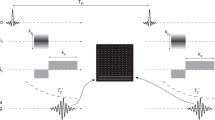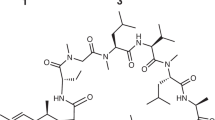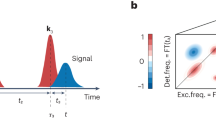Abstract
The method of nuclear paramagnetic resonance absorption1 has been used to study the interaction of nuclei in solids, liquids, and gases with their environment. The two important quantities are the relaxation time T1, describing the energy transfer from the nuclear spin system to the whole of the sample, representing the heat reservoir, and the interaction among the nuclei alone, which can be described by a spin-spin relaxation time T2. From the theory of Waller2 one can predict the relaxation time T1 caused by interaction of the nuclei with the lattice vibrations. The time obtained is at least 104 times larger than the experimental values3″4′5.
This is a preview of subscription content, access via your institution
Access options
Subscribe to this journal
Receive 51 print issues and online access
$199.00 per year
only $3.90 per issue
Buy this article
- Purchase on Springer Link
- Instant access to full article PDF
Prices may be subject to local taxes which are calculated during checkout
Similar content being viewed by others
References
Purcell, E. M., Torrey, H. C., and Pound, R. V., Phys. Rev., 69, 37 (1946).
Heitler, W., and Teller, E., Proc. Roy. Soc., A, 155, 629 (1936).
Rollin, B. V., Nature, 158, 669 (1946).
Bloch, F., Hansen, W. W., and Packard, M. Phys. Rev., 70, 474 (1946).
Bloembergen, N., Pound, R. V., and Purcell, E. M., Phys. Rev., 71, 466 (1947).
Wang, Ming Chen, and Uhlenbeck, G. E., Rev. Mod. Phys., 17, 323 (1945).
Debye, P., âœPolar Moleculesâ (New York, 1945), chap. 5.
Purcell, E. M., Bloembergen, N., and Pound, R. V., Phys. Rev., 70, 988 (1946).
Author information
Authors and Affiliations
Rights and permissions
About this article
Cite this article
BLOEMBERGEN, N., PURCELL, E. & POUND, R. Nuclear Magnetic Relaxation. Nature 160, 475–476 (1947). https://doi.org/10.1038/160475a0
Issue Date:
DOI: https://doi.org/10.1038/160475a0
This article is cited by
-
Hyperpolarized water as universal sensitivity booster in biomolecular NMR
Nature Protocols (2022)
-
Fast Na ion transport triggered by rapid ion exchange on local length scales
Scientific Reports (2018)
-
Proton relaxation in pure liquids and in liquids containing paramagnetic gases in solution
Il Nuovo Cimento (1955)
Comments
By submitting a comment you agree to abide by our Terms and Community Guidelines. If you find something abusive or that does not comply with our terms or guidelines please flag it as inappropriate.



